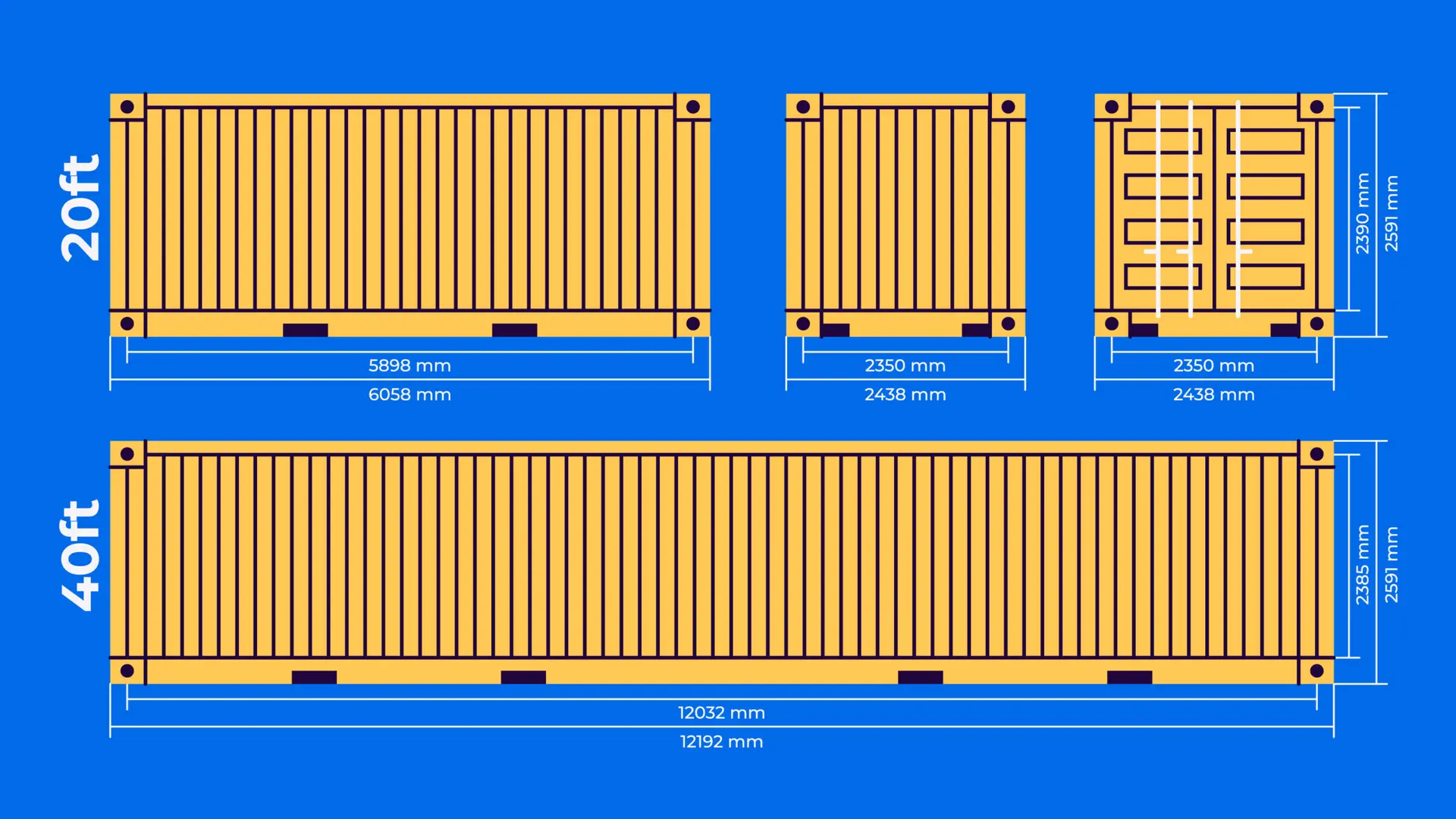Think all shipping containers are the same size?
Then you’ve probably never tried to squeeze a forklift, 300 archive boxes, and a pallet of paint into a 20-footer. Picking the right container size isn’t just a matter of space—it’s a matter of cost, logistics, and what you actually plan to do with it. The last thing you want is to hire a container, only to realise it’s either a shipping shed or a steel shoebox.
That’s why we’ve put together this size showdown.
In this article, we compare the three most popular container sizes used across the UK: 20ft, 40ft, and 45ft. Whether you’re using them for storage, shipping, site work or converting them into a portable bar (yes, really), we’ll help you understand what fits, what doesn’t, and how to avoid costly mistakes.
When it comes to containers, size does matter. A lot. Whether you’re a builder needing secure on-site storage, a business owner relocating stock, or a logistics manager handling international freight, picking the right size shipping container can make or break your operation.
Go too small and you’re wrestling with overflow. Go too big and you’re paying to ship air. At Containerlift, we move and deliver containers of all sizes, but the big three—20ft, 40ft, and 45ft—are the ones our customers ask about the most.
Each has its strengths, quirks, and best-use scenarios. A 20ft might be ideal for site storage or domestic use. A 40ft gives you the capacity of a small warehouse. A 45ft? That’s a behemoth—perfect for bulkier logistics or conversions into offices, canteens, or retail units.
In this article, we’ll break down the pros and cons of each size, explain what you can actually fit inside, and help you make the right decision for your next hire, purchase or delivery. Plus, we’ll throw in some bonus insights from our delivery experts on how each container behaves in the wild—because yes, container personalities are a thing.
H2: The Big Three – At a Glance
| Container | External Dimensions (L x W x H) | Internal Volume | Best For |
| 20ft | 6.06m x 2.44m x 2.59m | ~33.1 m³ | Site storage, small moves, retail |
| 40ft | 12.19m x 2.44m x 2.59m | ~67.6 m³ | Commercial storage, shipping |
| 45ft | 13.72m x 2.44m x 2.89m | ~86 m³ | Large equipment, conversion projects |
The 20ft Container — Compact and Capable
The 20ft container is the jack-of-all-trades in the world of steel boxes. It’s perfect for tight spaces, residential driveways, urban construction sites, and smaller jobs.
Pros:
- Easier to deliver and position
- Lower rental and transport cost
- Great for short-term or low-volume storage
Cons:
- Can’t fit long or bulky items
- Can fill up quicker than you think
Common Uses:
- Garden equipment and landscaping tools
- Domestic self-storage
- Event kit and gear
- Short-term building site lock-ups
The 40ft Container — The Industry Standard
Double the size of a 20ft, but not double the hassle. 40ft containers are the global standard for shipping and long-term storage. You’ll find them everywhere from ports to pop-up shops.
Pros:
- Maximum storage for minimal footprint
- Cost-effective per cubic metre
- Most common for commercial shipping
Cons:
- Needs more room to manoeuvre
- Slightly higher delivery and crane fees
Common Uses:
- Export logistics and freight
- Bulk commercial storage
- Furniture storage for house moves
- Workshop or mobile garage conversions
The 45ft Container — The Big Daddy
Think of a 45ft container as the penthouse suite of the shipping world. It gives you that extra 5 feet in length—and usually a bit more height (hi-cube models)—making it ideal for non-standard use cases.
Pros:
- Massive internal volume
- Great for container conversions
- Fewer containers needed for big jobs
Cons:
- Not always accepted for international shipping
- Harder to place on tight UK sites
Common Uses:
- Modular offices or classrooms
- Site kitchens and canteens
- Long-term stockpiling
- Oversized freight
So, Which Size Do You Need?
Ask yourself:
- How much do I need to store?
- How accessible is the drop-off location?
- Is this for storage, transport, or a conversion project?
- What’s my budget for delivery and space?
Our sidelifters can handle all three sizes up to 36 tonnes—so weight isn’t the issue. It’s all about practicality, purpose, and positioning.
What Our Drivers Say
We asked a few of our veteran sidelifter drivers what they prefer delivering:
“I love dropping 20fts in tight sites – quick in, quick out.”
“40fts are the sweet spot—big enough for anything, small enough to not be a faff.”
“45ft containers? Gorgeous on open ground. A pain on narrow city roads.”
A Note on High Cubes and Modified Units
Many 40ft and 45ft containers come in “high cube” variants—meaning they’re about 30cm taller than standard height. Perfect if you’re storing tall gear or converting them into spaces with ceiling lights or aircon units.
Modified containers (with doors, windows, insulation, electrics, etc.) often start life as 40ft or 45ft units—so your project might dictate the size automatically.
Case Study: Picking the Right Size for a National Retailer (≈500 words)
Client: Large UK-based furniture chain
Project: Deliver temporary stock storage to 40+ locations ahead of Black Friday
Problem: Mixed needs across different store sizes and car parks—some could only handle a 20ft container, others had the space for larger units.
Our Solution:
We carried out site assessments for each location and provided a tailored mix of 20ft, 40ft, and 45ft containers. The client was able to:
- Avoid overspending on unused capacity
- Maximise stock storage across larger stores
- Keep small urban sites functional with compact units
Impact:
- Saved an estimated £8,000 in storage costs
- Avoided delivery delays by choosing appropriate sizes for each store
- Made the best use of every square metre
Client Quote:
“Containerlift took all the guesswork out of this job. Each site got exactly what it needed—no more, no less.”
“Choosing the right container size isn’t about guessing—it’s about understanding your needs and your site. We help customers make the right call every day.”
— David Walters, Container Delivery Lead, Containerlift
Need help choosing between a 20ft, 40ft, or 45ft container? We’ve got the experience (and the vehicles) to deliver exactly what you need—anywhere in the UK or Europe. Get in touch and let’s get it sorted.









